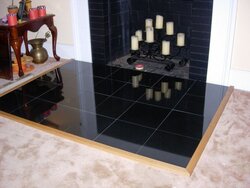Ceramic Tile vs. Stone Tile
Hello all,
I am building a hearth for my new stove (VC Defiant). My local tile distributor steered me away from stone tiles. He indicated they couldn’t support the stove without cracking.
He mentioned that the ceramic tiles were baked at a very high temperature therefore they would be harder/stronger. The stove is 450 lbs. w/o wood or the pipe weight. My wife and I really prefer the stone look to the tile.
Can anyone with some experience chime in here and give me some advice.
My plans for the hearth are a ¾” plywood layer, ½” fireproof cement board and then the tile/stone.
Thanks,
Joe
Hello all,
I am building a hearth for my new stove (VC Defiant). My local tile distributor steered me away from stone tiles. He indicated they couldn’t support the stove without cracking.
He mentioned that the ceramic tiles were baked at a very high temperature therefore they would be harder/stronger. The stove is 450 lbs. w/o wood or the pipe weight. My wife and I really prefer the stone look to the tile.
Can anyone with some experience chime in here and give me some advice.
My plans for the hearth are a ¾” plywood layer, ½” fireproof cement board and then the tile/stone.
Thanks,
Joe


